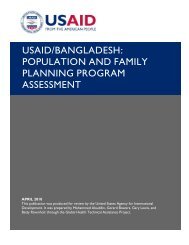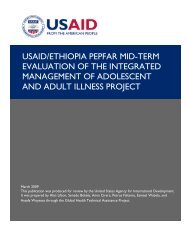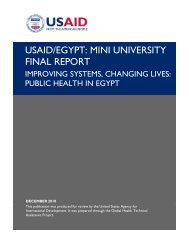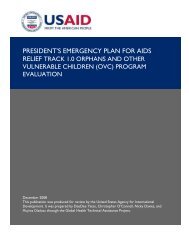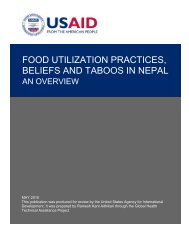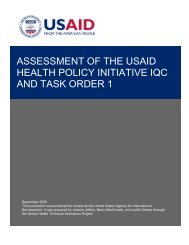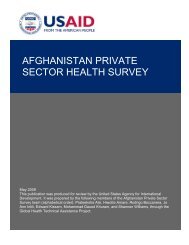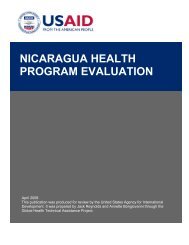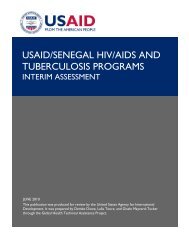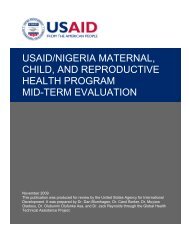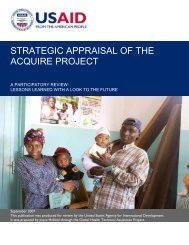Zimbabwe HIV/AIDS Partnership Project & Behaviour Change
Zimbabwe HIV/AIDS Partnership Project & Behaviour Change
Zimbabwe HIV/AIDS Partnership Project & Behaviour Change
- No tags were found...
Create successful ePaper yourself
Turn your PDF publications into a flip-book with our unique Google optimized e-Paper software.
1. INTRODUCTIONBACKGROUND: ZIMBABWE PARTNERSHIP PROJECTThe five-year <strong>Zimbabwe</strong> <strong>Partnership</strong> <strong>Project</strong> is funded by USAID/<strong>Zimbabwe</strong> through a task order mechanismunder the global Private Sector <strong>Partnership</strong>s-One (PSP-One) project. PSP-One is an indefinite quantity contract(IQC) awarded to Abt Associates, Inc., and its partners: Population Services International (PSI), Family HealthInternational (FHI), Banyan Global, and a number of local partners. The project began on October 1, 2005, and isscheduled to end on September 30, 2010. USAID/<strong>Zimbabwe</strong> also funds other groups (such as the ElizabethGlaser Pediatric <strong>AIDS</strong> Foundation, World Education, and SCMS through the JSI/DELIVER <strong>Project</strong>) working on<strong>HIV</strong>/<strong>AIDS</strong> in <strong>Zimbabwe</strong>.The <strong>Partnership</strong> <strong>Project</strong> was intended to help reduce the risk of sexual transmission of <strong>HIV</strong> by reinforcing thenational response to <strong>HIV</strong>/<strong>AIDS</strong> in <strong>Zimbabwe</strong> through a multipronged approach that includes increasing publicknowledge of <strong>HIV</strong> risks; promoting behavior change; reducing stigma; enhancing access to <strong>HIV</strong>-related productsand services (including T&C and PMTCT); and building the capacity of local research, policy, and service providersto address the epidemic.The project has a funding ceiling of $34,999,780 from USAID, and DFID provided separate funding of £20million over five years directly to PSI /<strong>Zimbabwe</strong>, a <strong>Partnership</strong> <strong>Project</strong> subcontractor, to implement the<strong>Behaviour</strong> <strong>Change</strong> Programme. Both donors agree on many of the same progress indicators and program targets.The context for the project has been extremely difficult. In the 1980s and early 1990s, <strong>Zimbabwe</strong> had one of thebest health systems in sub-Saharan Africa, but it has deteriorated in recent years as inflation shot up, governancebecame unstable, and the social infrastructure crumbled. Basic services like water and electricity are no longer agiven. Well-trained <strong>Zimbabwe</strong>an public health workers have left the country for better job opportunities elsewhere.The effect on <strong>Zimbabwe</strong>’s health indicators has been profound. For example, the 2006 Demographic and HealthSurvey revealed declines in nutritional status of children, number of births attended by a health professional, andavailability of essential drugs. It is within this context that the <strong>Partnership</strong> <strong>Project</strong> has been striving to achieve itsobjectives.A results framework (see Appendix A, Scope of Work) sets objectives for three project components,communications, product delivery, and services. The project was charged to use a broad range of guiding principlesto achieve the desired results, such as effective and innovative management and technical approaches; continuedlearning and ability to adapt as a result of experience; maximum use of local organizations; involvement of skilled<strong>Zimbabwe</strong>ans; integration of gender equity concerns; flexibility in responding to changes in the environment; andleveraging of other <strong>HIV</strong> resources.OBJECTIVES OF THE ASSESSMENTThe goal of this mid-term evaluation is to identify strengths and weaknesses to inform the future direction ofservices provided by the <strong>Partnership</strong> <strong>Project</strong> (see Appendix A: Scope of Work). USAID/<strong>Zimbabwe</strong> asked theevaluation team to assess emerging impact, review the continuing relevance of project objectives, and if necessarysuggest amendments to the program. It will be used by USAID, DFID, and the project to determine the course ofthe project through 2010 in terms of Whether or not the project is on target to achieve its goals as stated in the contract Strengths and weaknesses within the project portfolio Areas and activities that warrant continued investment, and untried initiatives and approaches that wouldlikely improve access to and use and quality of <strong>HIV</strong>/<strong>AIDS</strong> products and services Recommendations for mitigating weaknesses Recommendations for improving administration, coordination, and implementation of the project.<strong>Zimbabwe</strong> <strong>HIV</strong>/<strong>AIDS</strong> <strong>Partnership</strong> <strong>Project</strong> & <strong>Behaviour</strong> <strong>Change</strong> Programme: A Joint USAID/DFID Assessment 1




